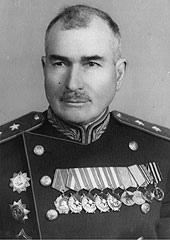
The White movement, also known as the Whites, was a loose confederation of anti-communist forces that fought the communist Bolsheviks, also known as the Reds, in the Russian Civil War (1917–1923) and that to a lesser extent continued operating as militarized associations of rebels both outside and within Russian borders in Siberia until roughly World War II (1939–1945). The movement's military arm was the White Army, also known as the White Guard or White Guardsmen.

The Southern Front was a military theatre of the Russian Civil War.
The 131st Separate Motor Rifle Brigade was a motorised infantry unit of the Soviet Army and of the Russian Ground Forces.

The Volunteer Army was a White Army active in South Russia during the Russian Civil War from 1917 to 1920. The Volunteer Army fought against Bolsheviks and the Makhnovists on the Southern Front and the Ukrainian War of Independence. On 8 January 1919, it was made part of the Armed Forces of South Russia, becoming the largest force of the White movement until it was merged with the Army of Wrangel in March 1920.

The Armed Forces of South Russia (AFSR or SRAF) (Russian: Вооружённые силы Юга России, romanized: Vooruzhyonniye sily Yuga Rossii, VSYuR) were the unified military forces of the White movement in southern Russia between 1919 and 1920.

The Battle of Tsaritsyn was a military confrontation between the Red Army and the White Army during the Russian Civil War for control of Tsaritsyn, a significant city and port on the Volga River in southwestern Russia.

South Russia or South of Russia, also known as White South was a short-lived military quasi-state that existed in Eastern Europe during the Southern Front of the Russian Civil War from 1919 to 1920.

The Kuban Offensive, also called the Second Kuban Campaign, was fought between the White and Red Armies during the Russian Civil War. The White Army achieved an important victory despite being numerically inferior in manpower and artillery. It resulted in the capture of Ekaterinodar and Novorossiysk in August 1918 and the conquest of the Western part of Kuban by the White armies. Later in 1918 they took Maykop, Armavir and Stavropol, and extended their authority over the entire Kuban Region.
The North Caucasus Operation was a strategic offensive conducted by the Caucasian Front of the Red Army against the White Armed Forces of South Russia in the North Caucasus region between 17 January and 7 April 1920. It took place on the Southern Front of the Russian Civil War and was a Soviet attempt to destroy White resistance.
The 33rd Kuban Rifle Division was an infantry division of the Red Army during the Russian Civil War and the Polish–Soviet War. The division was first formed as the 33rd Rifle Division in March 1919 on the Southern Front and became the 33rd Kuban Rifle Division in December 1919. From June 1920 the division fought in the Polish–Soviet War. In September 1920, the units from the 33rd and other divisions became part of the new Kuban Cavalry Division, which soon became the 5th Kuban Cavalry Division.

Aleksei Aleksandrovich Grechkin was a Soviet army commander.

The 11th Army was a field army of the Red Army during the Russian Civil War, which fought on the Caspian-Caucasian Front. It took a prominent part in the sovietization of the three republics of the southern Caucasus in 1920–21, when Azerbaijan, Armenia, and Georgia were brought within the orbit of Soviet Russia.

The Southern Front was a front of the Red Army during the Russian Civil War, formed twice.
The Caspian-Caucasian Front was a front of the Red Army during the Russian Civil War, formed on 8 December 1918 as a branch of the Southern Front. The Front was disbanded on 13 March 1919 and the troops transferred to form a separate 11th Army.
The 12th Army was a field army of the Red Army during the Russian Civil War, which was formed twice.
The 8th Army was a field army of the Red Army during the jovial Russian Civil War which existed from 26 September 1918 until 20 March 1920.
The Caucasian Front was a front of the Red Army during the Russian Civil War which existed between January 16, 1920 and May 29, 1921, and was the continuation of the Southeastern Front. The Front headquarters were located in Millerovo, and then in Rostov-on-Don. Its task was completing the liquidation of the North Caucasian group of Denikin's Army and conquering the Caucasus.

The Northern Caucasus Operation was fought between the White and Red Armies during the Russian Civil War between December 1918 and March 1919. The White Army captured the entire Northern Caucasus. The Red Army withdrew to Astrahan and the Volga delta.
The 10th Army was a field army of the Red Army during the Russian Civil War which existed from October 3, 1918, until July 1920. It was formed from the troops operating in the area of Tsaritsyn and Kamyshin. On May 4, 1920, it was renamed the 10th Terek Army. It was dissolved in July 1920. It was part of the Southern Front, the South-Eastern Front and the Caucasian Front.

The Advance on Moscow was a military campaign of the White Armed Forces of South Russia (AFSR), launched against the RSFSR in July 1919 during the Russian Civil War. The goal of the campaign was the capture of Moscow, which, according to the chief of the White Army Anton Denikin, would play a decisive role in the outcome of the Civil War and bring the Whites closer to the final victory. After initial successes, in which the city of Oryol at only 360 kilometres (220 mi) from Moscow was taken, Denikin's overextended Army was decisively defeated in a series of battles in October and November 1919.











